GLENDALE, Ariz. — Before the Raiders take the field for games in their new stadium, workers will move a 9,500-ton natural grass field into place on the stadium floor.
A massive 4-foot-deep tray loaded down with grass, sand, gravel, irrigation and drainage components will roll in on 13 rails through a 14-by-240 foot opening at the south end of the stadium. With the tray powered by 76 electric motors and moving roughly 11 feet per minute, the task will take about 90 minutes to complete before every Raiders home game.
Stadium architects devised the elaborate system to grow nearly an acre of grass on a portable tray outdoors and then wheel it into place for games in response to Raiders owner Mark Davis’ insistence that his team play on a natural-grass field.
The ground-level field tray aperture is one of two large openings that have been designed for the $1.8 billion, 65,000-seat indoor stadium under construction at Interstate 15 and Russell Road. The other huge stadium opening at the north end of the building will accommodate the 80-by-215-foot lanai doors that face the Las Vegas Strip at the plaza level.
The field tray won’t be unique to Las Vegas. In fact, the Raiders only had to look 283 miles south, to Glendale, Arizona, for a similar operation.
State Farm Stadium tray
State Farm Stadium, the 63,500-seat home of the Arizona Cardinals and the site of the annual Fiesta Bowl football game, was the first NFL facility to develop a moveable field tray that transports the playing surface indoors for games.
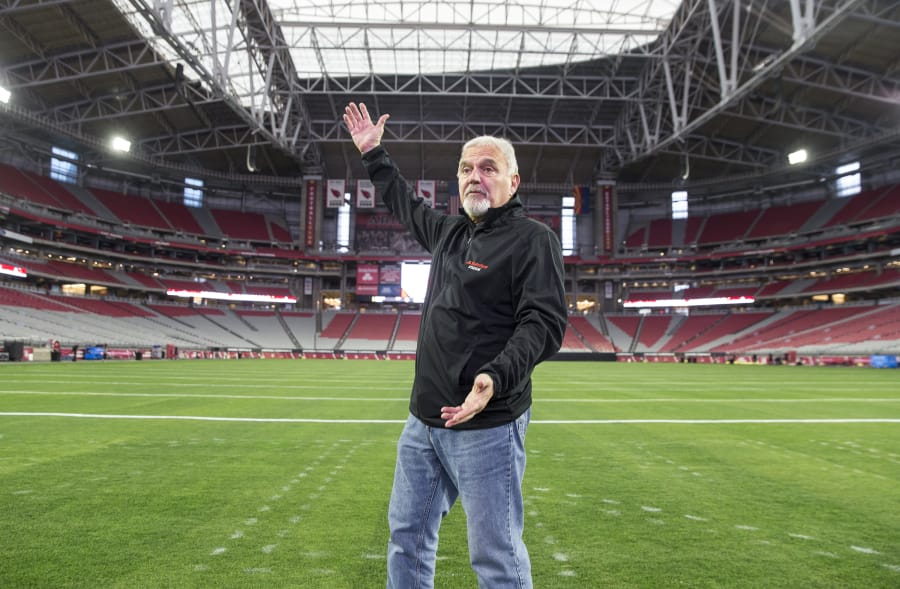
Fred Corsi, State Farm Stadium’s executive director of operations, oversees the field move-in, which usually occurs Friday afternoons before Sunday games.
The Arizona field move takes about 75 minutes to complete because the surface is slightly smaller than the one being developed in Las Vegas.
11 feet per minute
From a distance, the field tray containing the rye-Bermuda grass mix atop levels of sand and gravel, drainage and irrigation systems over rebarred concrete, motors and wheels on steel rails, seems to crawl.
Tray movement is powered by 48 electric motors. A power cord more than 200 feet long plugs into the front of the tray and powers it halfway into the stadium. At the halfway point, the cord is unplugged and moved to a rear electrical port to complete the journey.
The wheels roll atop 13 rails with a centered guidance rail that keeps the tray on a straight path.
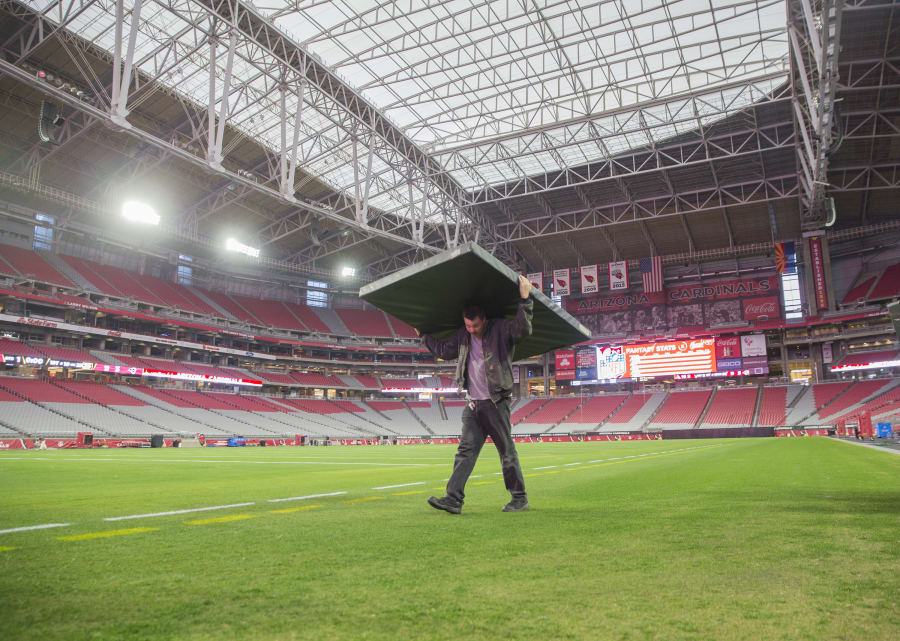
State Farm’s system has an underground servicing trench that the tray passes over before entering the stadium. The Cardinals recommended that the Raiders make their trench wider to accommodate the variety of ladders and equipment used to service wheels and motors.
Las Vegas Stadium developers have seen the State Farm system operate, learning efficiencies to make the Raiders’ version better.
The Las Vegas tray is expected to have 76 motors — enough redundancy so that the field can still move if three motors per side were to fail.
Dealing with extra weight
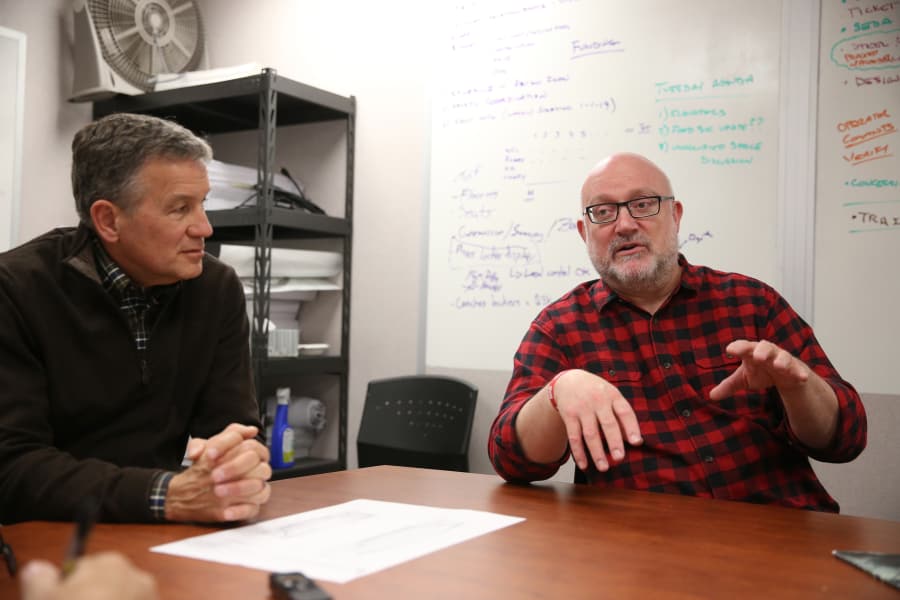
Don Webb, chief operating officer of the Raiders’ stadium development subsidiary, and Lanson Nichols, vice president of sports architecture for Kansas City-based HNTB, the architect of record for the project, explained the big differences between the Arizona tray and the one planned for Las Vegas.
The field-tray opening in Arizona passes beneath an elevated walkway that connects the two sides of the stadium. In Las Vegas, there will be seating and concourses above the tray opening.
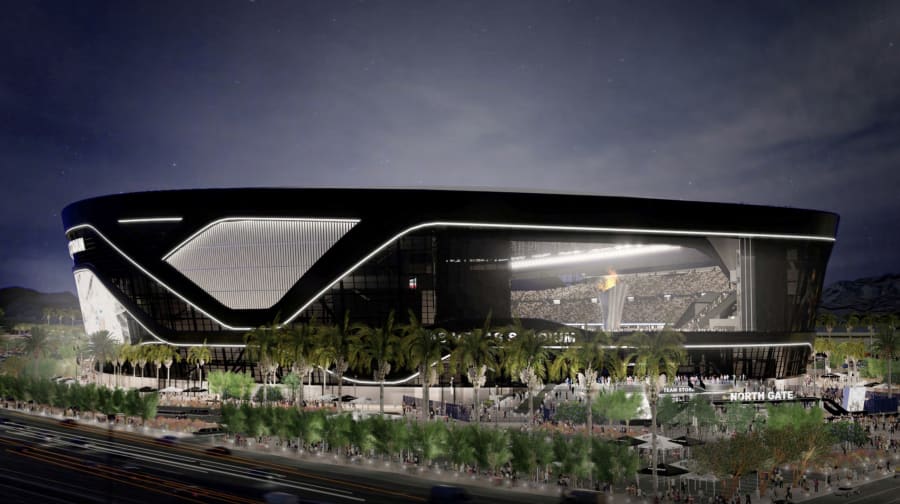
“When you start adding up all that weight at ours, you’re seating probably 7,000 to 10,000 people,” Webb said. “It’s not just all of the concrete for the concourses and the multiple decks, restrooms and everything else, but it’s the live load of maybe 10,000 people that are on that. Phoenix doesn’t have to deal with that, which means the support for all of that structure and weight at ours is much more robust than in Phoenix.”
There are enormous costs and engineering challenges of the system because we’re essentially building that portion of the stadium, a very heavy structure, on top of a bridge.
Don Webb, chief operating officer of the Raiders' stadium development subsidiary
Swiveling columns
To address this, the Las Vegas field-tray opening will have 22 columns that can swivel up or down and support the weight above it when a move is completed. The opening at State Farm Stadium has just two.
“There are enormous costs and engineering challenges of the system because we’re essentially building that portion of the stadium, a very heavy structure, on top of a bridge,” Webb said.
Safety procedures for each move are scheduled to be discussed this week by the Las Vegas Stadium Authority. Because there aren’t any safety protocols in place for anything like the field tray, the Stadium Authority drafted a stadium doors and columns operation agreement for review. A similar agreement was written for the the lanai doors at the north end of the building.
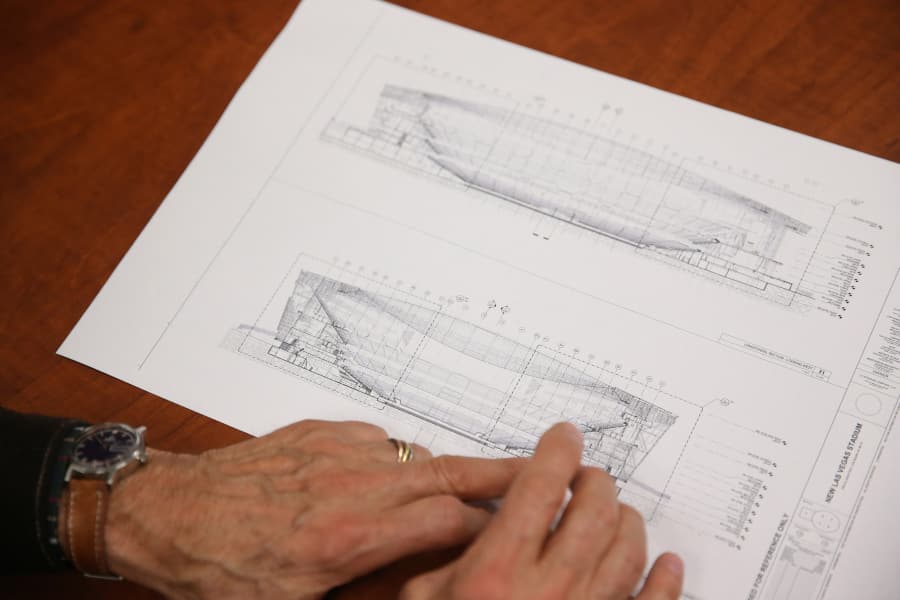
One of the safety rules will be that there can’t be any people in the sections above the field-tray opening when a field move is underway. Inspectors also will be required to be onsite for field moves as a safety requirement.
In addition to the grass, sand, gravel, irrigation and drainage components, the Las Vegas field will have heating elements because Southern Nevada winters are colder than Southern Arizona’s.
The Raiders haven’t determined what type of grass they’ll plant. They’re building a 25-by-40-foot mockup tray to test different types of grass as well as different spacing of heating elements. The Raiders have been in contact with Southern Nevada golf course managers for advice on the type of grass blend to use.
Like the Cardinals, the Raiders expect to have to resod the field at least once during the course of each season. For special events, there may be more resodding.
“You’ll typically resod before the Super Bowl or a big event like the college championship because you want it to look beautifully green and excellent for a broadcast,” Nichols said.
Artificial turf for UNLV
Another big difference between State Farm Stadium’s system and the one under construction in Las Vegas is that the concrete floor — a perfect base for trade shows or concerts — will be covered with artificial turf, the field surface of choice for the UNLV football team.
“This 4-foot-deep tray riding on 13 rails rolling in and out exposes the artificial turf that UNLV will be playing on,” Webb said. “It’s been designed so that it wouldn’t have to be removed for each game,” a big labor cost saving.
An extra 6 inches of clearance will enable the tray to move across the artificial-turf surface without disrupting it. Webb explained that turf “bacon strips” would cover the steel rails when the grass field is outdoors.

The artificial turf field will have end zones with UNLV’s scarlet and gray colors as well as UNLV logos on the turf and college field hash marks that lie closer to the sidelines than NFL field markings.
The Las Vegas field-tray opening will have a clearance of more than 14 feet, meaning tractor trailers will be able to drive onto the floor to unload equipment for concerts and trade shows.
“If it can fit under a bridge on the interstate, it’ll fit in our building,” Webb said. “That’s also perfect for TV trucks and team buses. It gives us a lot of back-of-the-house space.”
Contact Richard N. Velotta at rvelotta@reviewjournal.com or 702-477-3893. Follow @RickVelotta on Twitter.
Related story
Lanai doors will give Raiders stadium outdoorsy feel
Stadium Authority meeting
The Las Vegas Stadium Authority meets Thursday at 11:30 a.m., at the Clark County Commission chambers.




